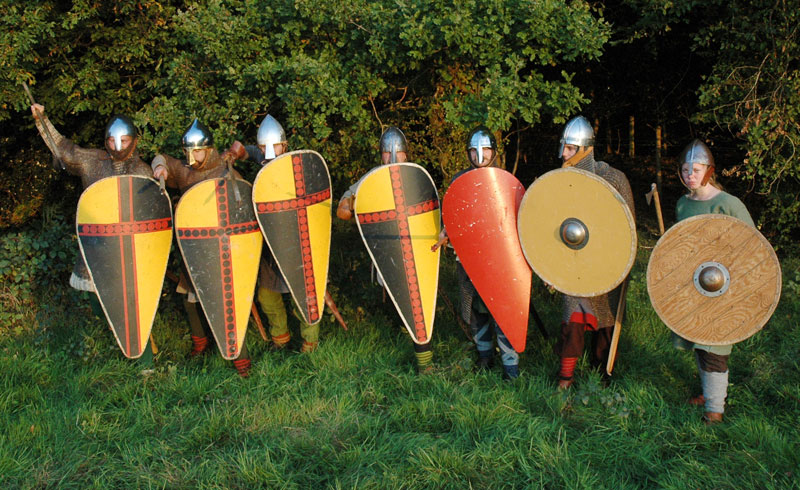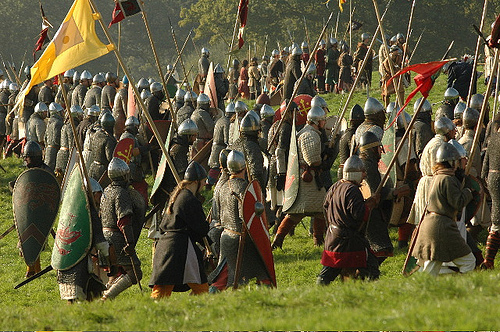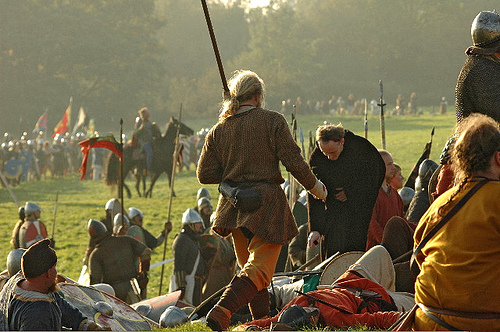Hastings 2006
On the 14th of October 2006, the 940th anniversary of the Battle of Hastings (and my birthday!) an enormous re-creation of the Battle was held on the battlefield itself - sponsored by English Heritage and organised by The Vikings, one of the premier re-enactment groups in Britain.
It was my privelege to play Earl Leofwine, the brother of King Harold, and leader of the Right Wing of the English army. Fortunately I was only a figurehead, just there to look pretty - they had proper commanders to tell the troops what to do. I got to make a speech to the troops and everything. And as the king's little brother, I had a personal hearth troop of huscarls, made up of re-enactors from Australia, Norway, America and England. We even had our own priest!

Leofwine's Australian huscarls - along with our sole representatives from the U.S. and the U.K. And Leofwine's Norwegian contingent.
A photoshoot with King Harold.
There were about 3,000 re-enactors at the event, many of whom camped in a "living history village", an accurate reproduction of an 11th century encampment. About 1500 combatants took the field – evenly divided between the two armies.
The English force was made up entirely of infantry armed with spear and shield. The elite troops, the huscarls, also had swords and two-handed axes.
The invaders were divided into three arms – about 50 archers, 100 cavalry with spear and sword, and the rest infantry, similarly armed. The re-creation was “choreographed” to follow the progress of the original battle as closely as could be determined from contemporary accounts. This was not easy - all disagreed with one another in the various details of the battle. Reconciling them to make a display that followed the best known events was a considerable labour. The English army marched into place at the top of the hill – first came the left wing, commanded by the King’s brother, Gyrth Godwinson, then I (playing Harold’s brother Leofwine) led the right wing into position. I stood at the extreme left of the right wing, surrounded by my hearth troop – a score of huscarls – half of them I’d recruited from Australia (seasoned combatants, with years of experience behind them in the rough and tumble of Australian re-enactment combat), half had come from Norway with John Saetrang, plus one huscarl each from America and England. Finally, King Harold led his contingent to the centre and took up his position under the Fighting Man banner and the Dragon of Wessex.
King Harold arrives with his huscarls, to the cheers of his troops. That's me in the white circle.
The Norman invaders arrived at the bottom of the hill and marshalled into position – archers at the front, then rank after rank of infantry, and finally the cavalry – about 100 knights in full armour. They and their horses had been training in cavalry maneuvres for the previous two days and were ready for battle.
Each leader rallied the troops – William to the invaders, Harold and Gyrth and I to our own beloved men, sharers in our hearth, defenders of our land and heritage. My voice broke (something to do with drinking and singing and shouting in the pub the previous night) as I shouted to the men of the right wing – “These Norman scum want to take your land – your wives, your children your homes. Are you going to let them do that? NO-O-O-O!!!
The huscarls stepped out in front of the English line, waving their two handed axes over their heads. (I’d thought this was pretty corny, but after the battle I spoke to a guy who’d played a Norman. He said the axemen’s demonstration was absolutely terrifying).
As well as the historically recorded battle cry “Ut! Ut! Ut!” (Out! Out! Out!) – as King Harold was the son of Earl Godwin, it has become customary for English re-enactors at Hastings re-enactments to call out the battle cry “Godwinson! Godwinson!”, for which there’s no historical evidence. What there is evidence for is the cry "Halig Cros" (Holy Cross) and ”God Aelimihtig” (God Almighty!). I managed to get my guys using these (but not enough to drown out the Godwinson chant).
William’s archers began the combat, loosing a shower of arrows high into the air, dropping onto the English lines at the top of the hill. Casualties were low – shields and helmets protected the English forces. Though the arrows had blunt rubber heads, they stuck in the clayey ground when they hit. One English warrior, head bowed, had an arrow strike him down the back of his neck, between the helmet and the mail shirt. Not pleasant.

The Norman army marshalled for attack, archers to the fore. The English army awaits them at the top of the hill. The Norman archers begin the assault and the arrows arrive at the English shield wall.
On Norman knight – William’s minstrel, Taillefer, rode toward the English lines, singing the Song of Roland and juggling his sword in the air, throwing it high and catching it. He challenged any Englishman who dared, to face him man to man. One huscarl came forward – a brief skirmish followed. Taillefer was victorious. He spurred his horse and attacked the English shieldwall all alone, vanishing into the English line. He was not seen again.
Spurred by his example, the infantry came up the hill – about 600 strong. Franco-Flemings on the right, Norman in the centre and on the enemy left, facing my own contingent, 200 Bretons, in three ranks.
We braced ourselves for the clash of shields. The line held, as we pushed back against the attack of the foreign invaders, then slowly we began to push them back. The front rank of the Bretons retired, to be replaced by their second line. We took advantage of the lull to replace our front line with fresh warriors from the second rank. Battle began again, but with the same result. The Bretons fell back, to be replaced by their third rank, whom we faced with our own third line.

The Norman infantry advance up the hill.
But the English shield wall held firm, and William’s infantry were worsted. The whole line retreated down the hill to where they had started.
Then William led his cavalry forward, up the hill. Starting slowly, the horses built up to a gallop, approaching the English shield wall. The English held firm, a thicket of spears pointing outward. The cavalry threw javelins at the shield wall, then turned sideways, riding along the English line, striking at the defenders.

Norman cavalry attack the English shield wall.
Videos of the cavalry charge can be seen
here and
But even the cavalry could not break the defenders. The Norman knights turned and rode back to their own lines. At the top of the hill, a number of huscarls moved out in front of the English lines, and taunted the Normans by turning their two handed axes into hobby horses, riding up and down in front of the shield wall.
The archers began again, sending a storm of arrows high into the air. Again, he plunging shots were relatively ineffective, and the infantry had to trudge back up the hill. Again, we faced the Bretons of the invaders’ left wing.
Now the Breton infantry were scripted to break and run down the hill, while a group of our own men followed them down, to be surrounded and massacred by the Norman cavalry. And I was to run down to turn them back, get separated from my huscarls and get cut down by William of Normandy. Unfortunately, we didn’t get our “cue”, so the Bretons had to do it all again.
As our warriors streamed down the hill, I tried to turn our men back. An English axeman came running down at me, and seeing that I was facing up the hill, got it wrong. Waving his two handed axe over his head, he shouted “Die Norman scum!” I replied in kind – “I’m your f**cking EARL, you bastard! Now TURN AROUND!
The previous day, I’d met with “William” to let him know what I looked like, so he knew who to aim at. And there he was, riding toward me. I beckoned him over, we did a bit of bash bash, and down I went.
My hearth troop came up to me, and crying ”Wala! Wala!” (Alas! Alas!). They picked my body up, forming a defensive ring, and carrying me back to our lines at the top of the hill.

The Bretons on the Norman left break and run, pursued by the English Right. Norman cavalry hit the English from the flank, killing many. Trying to turn my troops back, I become separated from my hearth troop and am mortally wounded.My hearth troop defends my body, carrying it back to the English lines.
My hearth troop stood around me to protect my body, but got a bit bored being left out of the fighting. So I told them to go and have fun. I just lay there enjoying the weather. I missed the rest of the battle, except as a spectator. But I had a nice little lie down.
The battle raged on. Seeing the result of the earlier English attack, William ordered a feigned flight on the right wing. The English left followed down the hill, and was massacred, along with its leader, King Harold's other brother, Gyrth. After that, the cohesion of the English line began to crack, and holes appeared in the shield wall. Finally, the cavalry broke through, and Harold was killed. The English fought to the end, but the battle was lost.
King Harold is dead. The English line finally collapses.

Priests deliver the last rites to the fallen. In the background we can see William Of Normandy on his horse.
The battle was over. The victorious Normans moved off, marching past the audience. We English followed, to the cheers of the crowd, calling out our war cries.
For galleries of photos see: